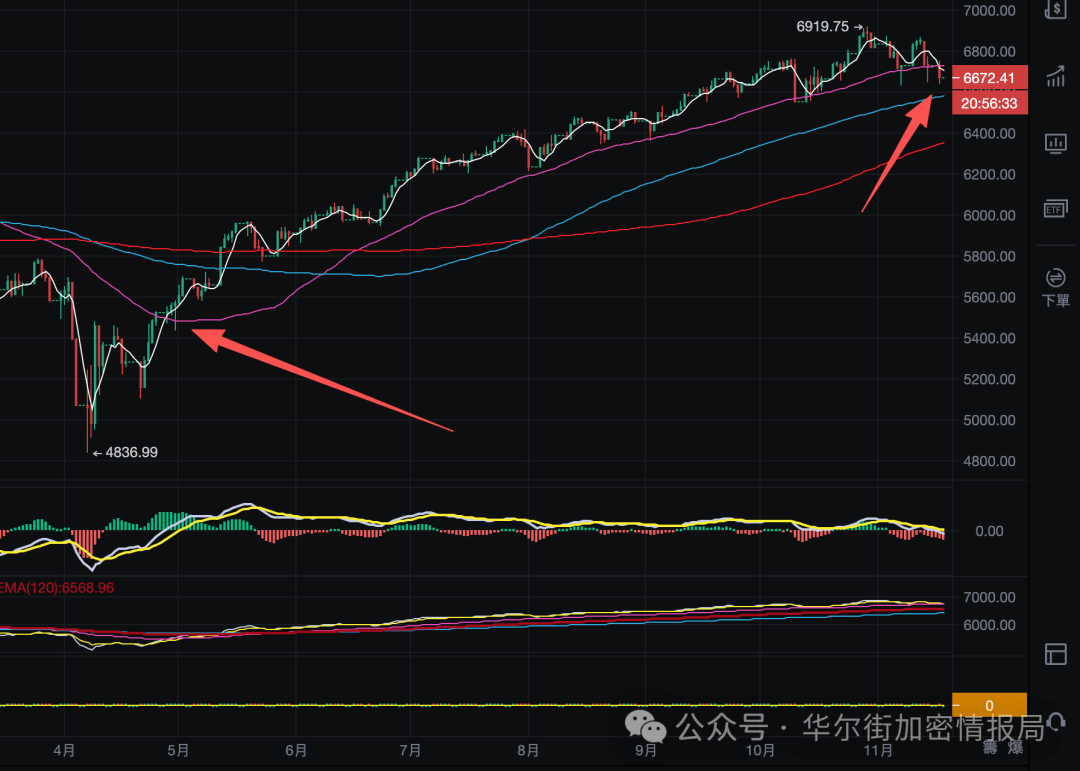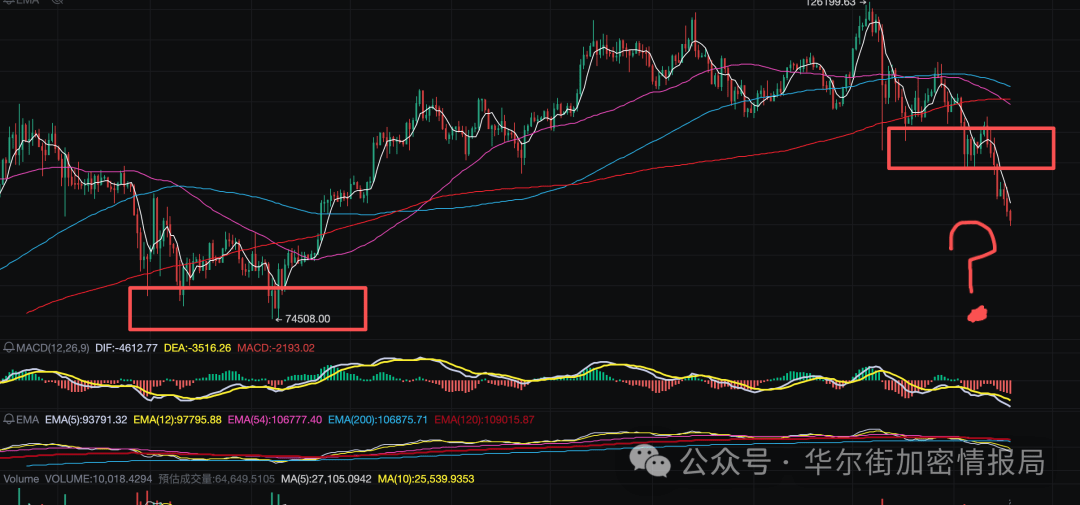The market originally thought: breaking below 95,000 USD would quickly rebound to above 100k USD,
Result: After the US stock market opened on Monday night, technology stocks, the cryptocurrency circle, and gold faced a 'triple kill', the US stock market broke through key support levels, and the American market encountered a 'full-scale sell-off'.
Now the market is firmly convinced: the bear market has arrived, and the bull market hasn't been seen at all!
The biggest problem at this stage is: liquidity is extremely low, there is no outside capital entering the market, and there are no positive news to be seen, large funds are hedging, and small funds are in panic, which has led to the current endless situation.

The S&P and NASDAQ both broke key technical levels; gold fell to around $4000; Bitcoin once fell below $92,000, completely wiping out its gains for the year.
The cooling of the AI craze, key macro data approaching, institutional withdrawals, and quantitative deleveraging have collectively created the macro backdrop for this round of 'synchronized asset sell-off'.
When Bitcoin's gains for the year all disappear overnight.
When ETF funds retreat, macro hedging escalates, and retail sentiment collapses – this round of decline is not coincidental.
When 'digital gold' falls back to square one, the real turning point for the crypto market may be quietly resetting.
What happened in the global market on Black Monday?
On Monday, the US financial market experienced severe selling:
The Dow fell 1.2% (557 points); the S&P 500 and NASDAQ broke the 50-day moving average (for the first time in 138 trading days); tech stocks have become the hardest hit.

And it's not just stocks that are declining synchronously:
Spot gold drops to around $4000
Gold futures dropped to $4068.30
Bitcoin instantly fell below $92,000, and its gains for the year turned negative.
The VIX index soared to a new high since April.
What does this mean?
The market has entered a 'fear-driven' high-correlation moment, with multiple assets declining simultaneously and liquidity rapidly tightening.

Four core drivers: Why can't all assets hold up?
① The AI craze has entered a 'scrutiny phase,' and NVIDIA's earnings report has become the biggest uncertainty.
AI is the core logic behind this year's rise in US stocks. But now the market is starting to ask: Has AI's capital expenditure peaked? Are the profits matching?
NVIDIA's earnings report is about to be released; tech giants are heavily in debt (building data centers, AI servers); the credit market is beginning to show 'solvency anxiety' for AI infrastructure companies.
Oracle, AMD, CoreWeave, and other companies' stock prices have significantly weakened, indicating a collective concern that 'AI valuations are too high.'
② Fed's interest rate cut expectations are wavering, and the noise in macro data is exacerbating market fear.
This week will announce: delayed September employment data; NVIDIA's earnings report.
At the same time, the Fed's vice chairman reiterated: 'We need to proceed slowly on the interest rate cut issue.'
Market bets on a rate cut in December have begun to decline, putting pressure on asset prices.
③ The credit market is the first to sound the alarm: Amazon's bond issuance has cooled.
Amazon issued $15 billion in bonds: nominally 'actively subscribed'; but the final pricing spread was higher than existing bonds → investors demand higher risk premiums.
At the same time, the credit spreads for high-yield and investment-grade bonds have widened significantly. The tech giants' model of 'massive debt to build AI factories' is being questioned:
'There are winners, but there will also be AI companies that cannot survive in the new world.'
The deterioration of the credit market is the biggest invisible driving force behind this round of risk assets' collective sell-off.
④ Risk assets are fully 'deleveraging' – Bitcoin igniting a chain reaction.
The true key to this round of decline: leveraged longs were forcibly liquidated; quantitative CTAs switched from buying to selling; liquidity was suddenly withdrawn.
Bitcoin is even worse: the 50-day moving average crosses below the 200-day moving average → a death cross occurs; Coinbase's stock price plummeted by 7.1%
Gold should be a safe haven, but this time it also fell:
This shows that the market is not 'risk transfer,' but rather 'liquidity absence.'
Technical analysis and on-chain data: where is Bitcoin's key support?
1) Bitcoin forms a death cross (short-term bearish)
Historically, BTC's death crosses are often accompanied by further declines
The last death cross in April saw a temporary new low. If it doesn't stop falling now, it means we haven't hit the bottom yet.
When will we hit the bottom? Just like that time in the first half of this year, at least 3 bottom tests are needed to end it. The bottom is bought; at this position, everyone thinks it's the bottom.
The biggest problem with the current market situation is: the pattern has deteriorated, and the market is in panic!

2) The most important support zone on-chain: ≈ $80,000 (miner's breakeven price)
Miner income and cost models show:
$80,000 is the common bottom line for institutions + miners.
If prices fall to this area: many miners may choose to reduce production and retain inventory.
Long-term funds (institutions, ETFs) will view it as a 'strategic accumulation position'

NVIDIA's earnings report disaster will accelerate market decline
AI is the core driving force behind this round of US stock market rise. If NVIDIA's earnings report shows a disaster, the market will panic even more, and the entire financial market will face a new round of crash.
But this probability is very low, less than: 2%
The US stock market will drive BTC's decline.
This week's CPI and employment data, if poor, will lead to continued outflows and large redemptions from ETF institutions, accelerating the market's downside risk. If there are no rate cuts in December, then a new round of global financial crisis will really come!
At that time, 95% of people in this round of bull market will truly have played in vain.
Holding coins for four years, suddenly returning to square one, still not knowing where BTC's bottom will really be?
The market has reached this trend
My opinion:
BTC touching around $8.5k is basically a certainty.
Within 2025, there will be a decent rebound around 107k; it will be hard to have a big market movement in the next two months as the pattern has deteriorated and the market needs to repair itself; be rational and don't set unrealistic expectations.
We respect the market and fear the market. Only then can you profit in the market.
Altcoins, if you want to operate, must find: very strong, resilient ones, and never bottom-feed!!!

This is not the endgame, but the beginning of structural turnover.
This round of plunge is neither a systemic crisis nor a black swan, but rather: institutional rebalancing; AI risk re-pricing; ETF liquidity reversal; the chain reaction of market-wide deleveraging.
The long-term logic still holds:
Bitcoin is still in an institutionalization cycle; the US fiscal deficit and monetary easing will eventually return.
On-chain non-owner assets (Bitcoin) remain the world's only 'non-taxable, non-inflatable' super-sovereign asset
Although the short-term market is experiencing violent fluctuations, for professional investors:
The more chaotic the turning point, the more it requires steadfastness, restraint, and in-depth research.
The market is experiencing a painful but
A necessary 'structural reset.'
The cooling of the AI narrative, rising macro uncertainty, ETF outflows, and forced deleveraging have caused all assets to enter a high volatility zone simultaneously.
But this is not a full-blown crisis; rather, it's a necessary phase where institutional funds are re-pricing risk, the market is deleveraging, and liquidity is being reconstructed.
Bitcoin falling below the initial opening price of the year does not mean the end of the cycle; on the contrary, it is approaching a strategic support zone of consensus between institutions and miners.
Short-term fluctuations may still be downward, but the medium-term structure has not been broken: fiscal deficits, interest rate cut cycles, and the reactivation of market liquidity will reshape the pricing framework for risk assets in the future.
At this stage, the most crucial thing is not to predict rises and falls,
Instead, maintain rationality: don't chase highs, don't bottom-feed, move less, look more.
True reversals often occur in the most panicked moments;
The true winners are always those who can cut through the noise and see the cycles.
Deep observation · Independent thinking · Value goes beyond price.
Star #Wall Street Crypto Intelligence Agency, don't miss good content⭐
Finally: many views in this article represent my personal understanding of the market and do not constitute advice for your investments.

